The Chinese Meteorological Society
Article Information
- Xinyuan FENG, Changhai LIU, Guangzhou FAN, Jie ZHANG. 2017.
- Analysis of the Structure of Different Tibetan Plateau Vortex Types. 2017.
- J. Meteor. Res., 31(3): 514-529
- http://dx.doi.org/10.1007/s13351-017-6123-5
Article History
- Received July 25, 2016
- in final form January 15, 2017
2. National Center for Atmospheric Research, CO 80307, USA;
3. Collaborative Innovation Center on Forecast and Evaluation of Meteorological Disasters, Nanjing University of Information Science & Technology, Nanjing 210044, China
The Tibetan Plateau, soaring into the middle troposphere, not only plays an important role in global atmospheric circulation via its thermal and dynamic forcing, but also considerably affects the weather over the plateau and its widespread downstream region through a unique and frequent weather system: the Tibetan Plateau vortex (TPV). The TPV is defined as a shallow cyclonic meso-α-scale low-pressure system that originates over the main body of the plateau in the warm season and presents most notably at 500 hPa (Luo, 1992). The vortex is the main precipitation-inducing weather system over the plateau in the warm season. When moving out of the plateau region under certain suitable large-scale synoptic conditions, it can also induce torrential rainfall and other hazards in the downstream region, even resulting in floods along the Yangtze, Yellow, and Huaihe rivers.
The structure of the TPV has been an important topic of research over the last few decades, because of its close relationship with generation and development mechanisms. The zonal anomaly of temperature, referring to the temperature deviation at a given point from the mean value along the same latitude between 75° and 100°E at the same level, is often used to describe the thermodynamic structure of the TPV (Lyu and Zheng, 1984; Qian et al., 1984). TPVs are categorized into two groups according to their thermodynamic structure: warm versus baroclinic (or cold) vortices (Lhasa Research Group on Qinghai–Xizang Plateau Meteorology, 1981; Qian et al., 1984). A vortex is defined as a warm system if it occurs in the vicinity of a high temperature ridge without cold air intrusion and shows the presence of positive 24-h temperature change nearby the vortex center; meanwhile, a baroclinic (or cold) vortex is accompanied by either a temperature trough or frontal zone and occurs in the presence of negative 24-h temperature change or positive allobaric values; and a warm vortex is a shallow and anomalously warm system, but the warm core does not overlap with the low-pressure center, and the spatial distributions of physical fields are asymmetric—except the vorticity field (Lhasa Research Group on Qinghai–Xizang Plateau Meteorology, 1981). Diagnostic analysis on a TPV occurred during 6–9 June 1979 has revealed that the TPV in its initial stage, centered around 32.5°N, 90°E in western plateau, was the warm vortex, whereas the mature TPV, whose center has moved to around 32°N, 95.5°E in eastern plateau, has transformed into a cold vortex with a cold center at low levels and a warm center at upper levels nearby; except for their thermodynamic properties, there are no remarkable differences in other physical fields between initial and mature vortices (Lyu et al., 1984). If the vortex continues to move out of the plateau, the thermal and dynamic structure could vary (Liu et al., 2009; Wang et al., 2009). The structure of some TPVs is similar to that of tropical cyclones, because of certain similarities in the nature of the underlying surface between the plateau and tropical ocean during the warm season. The structural features have been verified through objective analytic and energy diagnostic methods (Luo et al., 1993). Moreover, satellite images indicate that the cloud pattern of a TPV in midsummer looks like that of a tropical cyclone over the ocean, with a visible spiral structure (Qiao and Zhang, 1994). The presence of a TPV “eye” (i.e., a cloudless area over the vortex center—similar to the situation in a typical cyclone) has been reported from a dynamics perspective (Li and Jiang, 2000).
When a TPV moves out of the plateau it is evidently affected by the South Asian high (SAH). As the SAH extends east at 200 hPa, northwesterly flow in front of the ridge dominates eastern plateau, creating a favorable environment for the vortex to move eastward out of the plateau (Gao and Yu, 2007). An analysis of the upper-tropospheric circulation of five rainstorm-producing TPVs that moved out of the plateau during 1998–2004 indicated that the range of flood-inducing heavy rainfall produced by such vortices is associated with the SAH’s pattern at 200 hPa; that is, a northwardly arch of the SAH mainly affects the middle reaches of the Yangtze River valley, while a bar form of the SAH influences the valleys of the Yellow and Huaihe rivers (Yu et al., 2007). However, vortices that move out of the plateau only constitute a small portion of all TPVs. Currently, the impacts of the SAH on vortices that do not move out of the plateau, as well as on the structure of the vortex system, remain unclear.
To summarize, most previous studies on TPV structure have focused almost exclusively on cases associated with strong convection/precipitation, or that were large in size and were particularly prominent on weather maps. These studies have attained a number of meaningful re-sults through diagnostic and dynamic analyses and numerical simulations. However, rawinsonde stations on the plateau are quite scarce (Fig. 1), and so observations are insufficient for achieving a thorough understanding of the vortex (it is a mesoscale system with a typical horizontal scale of just a few hundred kilometers). This obviously restricts our knowledge on TPV systems. Besides, few studies have paid attention to vortices characterized by weak convection or precipitation (or even non-precipitating vortices), which in fact are very common. We noticed that the TP vortex system exhibits unique complexity and variety in structure, with more categories than previously known, when performing a statistical survey of TPVs (Feng et al., 2014). It therefore becomes necessary to further classify TPVs, in terms of their structure, based on investigating a large number of samples through high-resolution reanalysis data, and then systematically analyzing the structures of the various types of vortices.

|
| Figure 1 Terrain (shading) of the Tibetan Plateau and the geographical distribution of rawinsonde stations (black dots) on the plateau and its nearby surroundings. The bold black line is the elevation contour with a value of 3000 m. |
In the present work, a high-resolution reanalysis data are used to systematically investigate the general structural characteristics of various types of TPV at maturity, through inspection and physical classification of a large number of systems followed by composite analysis. Our primary aim is to explore the general structural features in each category, and to compare vortices observed in various regions and in different seasons, as well as those possessing distinct translation behavior. The hope is that the present work will lay a foundation for future numerical modeling and theoretical studies of the formation and development mechanisms of various types of TPV.
2 Data and method2.1 DataThe data used in this study come from the NCEP-CFSR (Climate Forecast System Reanalysis). This dataset, initially completed in 2010, is a global high-resolution coupled atmosphere–ocean–land-surface–sea-ice system, with a modern assimilation system and forecast model. The CFSR includes all available conventional and satellite observations, as well as aircraft observations and special observation programs. The output products are available at a 0.5° horizontal resolution and an hourly temporal resolution, consisting of daily analyses at 4 times (from 0000 to 1800 UTC, every 6 h) and 1–5-h forecasts for each analysis time. The dataset is substantially superior, in most respects, compared to the previous NCEP global reanalysis completed in the 1990s (Saha et al., 2010). The CFSR has been widely used in climatological, large-scale meteorological, and mesoscale meteorological studies (e.g., Weaver et al., 2011; Alexander et al., 2012; Wen et al., 2012; Dieng et al., 2014; Li and Colle, 2014; Feng et al., 2016).
Owing to its high resolution, the CFSR dataset is arguably suitable to analyze the TPV, which is a mesoscale system with a horizontal scale of just a few hundred kilometers. The high horizontal resolution ensures that there are enough grid points to represent the vortex, and its high temporal resolution makes it easy for the evolution of the system to be characterized in detail. Some studies (Wang and Zeng, 2012; Bao and Zhang, 2013) have evaluated several reanalysis datasets, including CFSR, by using not only in-situ observations at meteorological stations, but also measurements from field campaigns [the Coordinated Enhanced Observing Period Asia–Australia Monsoon Project on the Tibetan Plateau (CEOP-CAMP/Tibet); the Tibetan Plateau Experiment (TIPEX)] over the plateau. Their results show that CFSR performs better than the NCEP predecessor, with the latter having been widely used in research over and around the Tibetan Plateau in the past few decades.
In previous work, we performed a statistical survey of the TPVs that occurred during April–October from 2000 to 2009, documented their climatological properties, and attained some new and meaningful results using 3-h CFSR data (Feng et al., 2014). The main results in terms of climatological statistics with the CFSR data, such as TPV genesis distribution, were generally consistent with findings from other statistics using the previous NCEP reanalysis (Li et al., 2014) and ERA-Interim reanalysis (Lin, 2015). Essentially, the results proved the suitability of CFSR for TPV research, and verified its superiority compared to the previous-generation reanalysis.
2.2 MethodologyThe TPV detection algorithm used in this study is described in detail in Feng et al. (2014). Briefly, a disturbance originating in the interior region of the plateau is defined as a TPV if it is a mesoscale cyclonic vortex in the 500-hPa streamline and relative vorticity fields, and is characterized by a low-pressure system with closed contours in the 500-hPa geopotential height field. Based on a survey, two years with normal TPV activity (2005 and 2007) are chosen to inspect the structures of all 220 cases at maturity for the two years. Herein, the mature stage refers to the CFSR analysis time at which the vortex attains its maximum relative vorticity. According to the structural characteristics and precipitation situation (i.e., existence or non-existence of precipitation), as well as seasonality (i.e., seasonal preference in genesis) and geographical position, these vortices are grouped into several types. Then, for each category, about five representative cases, which are close to each other in terms of their geographical position, are chosen for composite analysis. Based on the activity statistics of all vortices for each category, the present work focuses on the composite thermodynamic and dynamic structures in order to explore the primary universal features in structure for each category of TPV. To obtain the physical fields of the composite vortex, the reanalysis grids of each TPV are shifted, resulting in the location of the composite vortex center at 500 hPa being the mean position of these TPVs.
3 ResultsThe dynamic and thermodynamic structures of the TPVs are deeply affected by their geographical location, season, translation properties, and precipitation situation. Four categories of vortex systems with distinct structures have been identified. Type II is further separated into two sub-categories, that is, type IIa and IIb. The various categories of vortices account for 45% (type I), 12% (type IIa), 10% (type IIb), 15% (type III), and 5% (type IV) of the total number.
3.1 Common precipitating TPVs generated in the large-scale confluence zone (type I)Type I is quite common and often initiates precipitation. It has a wide geographical distribution, but most frequently in the west–east-oriented zonal region between 33° and 36°N, as shown in Fig. 2a. The location of the zonal region agrees well with that of the large-scale confluence zone in the 500-hPa mean streamline field during the warm season (Feng et al., 2014). The moving vortices predominate, accounting for 74% of this category. Based on our previous statistical work, a vortex is defined as a moving system if the zonal displacement during its lifetime is more than 2° of longitude; otherwise, the vortex is classified into a quasi-stationary system (Feng et al., 2014).
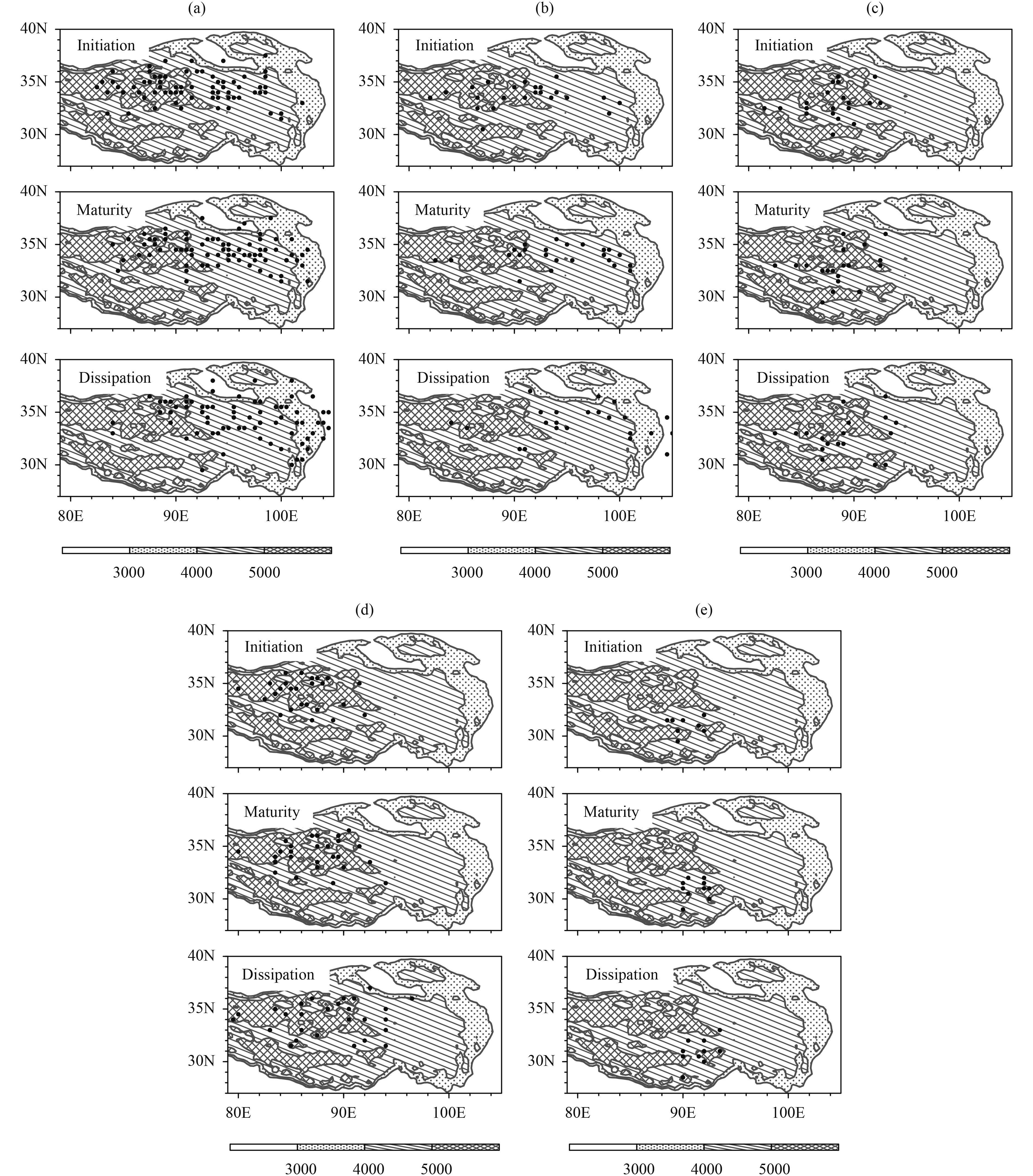
|
| Figure 2 The locations (black dots) of initiation, maturity, and dissipation for all TPVs of (a) type I, (b) type IIa, (c) type IIb, (d) type III, and (e) type IV. The shaded area represents the extent of the plateau, and the different fill patterns correspond to elevations higher than 3000, 4000, and 5000 m, as indicated in the key at the bottom of each sub-figure. |
The composite vortex is an asymmetric system in the horizontal physical fields. It is centered at 34.5°N, 95°E at 500 hPa and is vertically confined to a layer between 550 and 400 hPa in the geopotential height field. The vortex system is notably baroclinic and resides within a zone of apparent meridional gradient of potential temperature within 550–450 hPa, as shown in Figs. 3c, 4b. The centers of low pressure and positive vorticity weakly tilt northward with height, whereas the convergence center presents a pronounced tilting. At 500 hPa, as shown in Figs. 3a, c, the vortex is situated in the large-scale confluent region of the northwesterly/northerly and southwesterly flows, and develops in a low-pressure trough. It takes on a visible westward elongated morphology in the 500-hPa geopotential height, relative vorticity, and convergence fields. The vortex system is coupled to a shallow mesoscale trough at 400 hPa and then transitions into a localized mesoscale high ridge within 300–175 hPa. A warm center occurs between 400 and 300 hPa, with its warm core overlapping the vortex center. The upper troposphere over the main body of the plateau is controlled by the straight westerly flow. The ridge line of the SAH lies along ~23°N at 200 hPa (Fig. 5a).
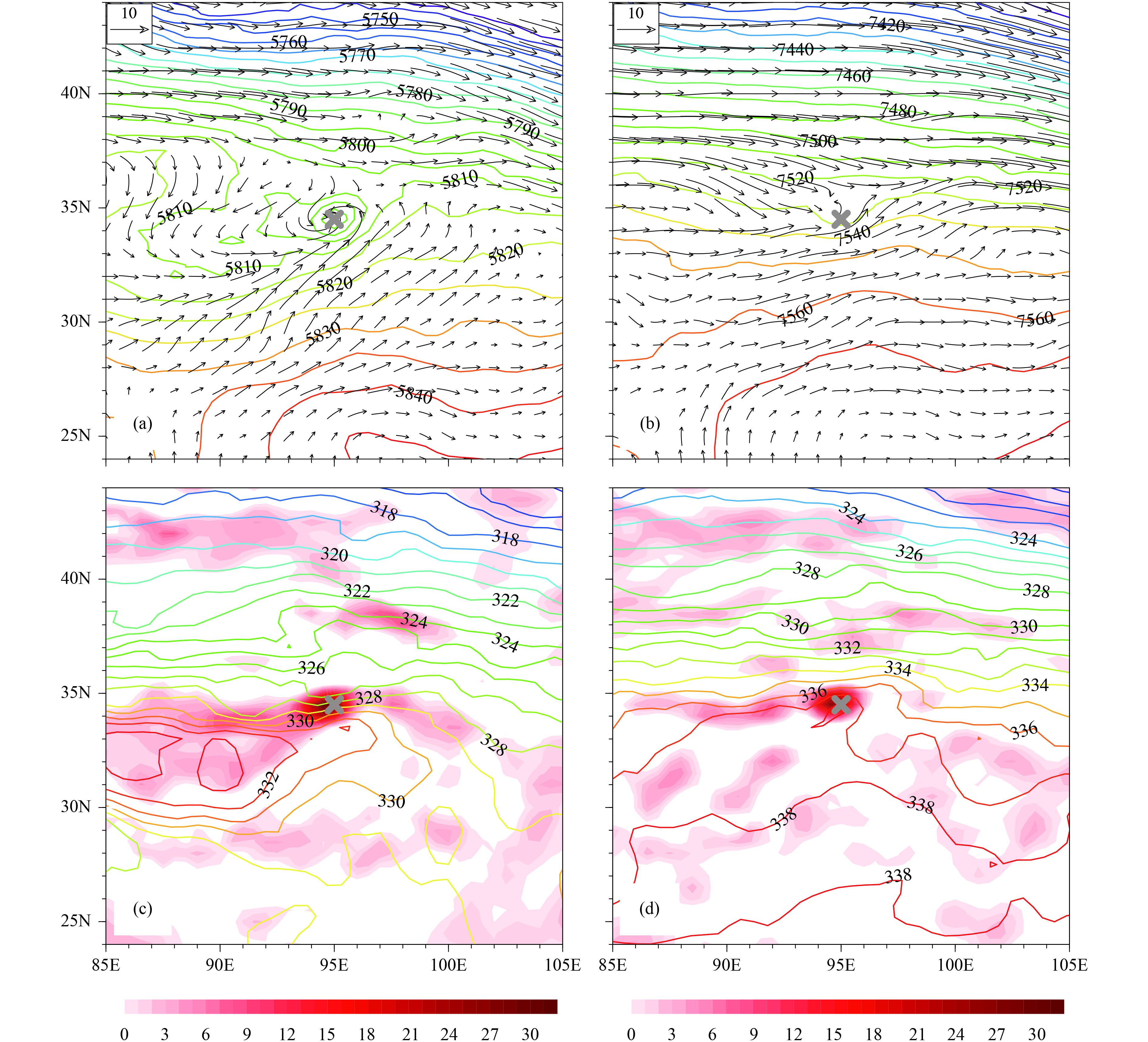
|
| Figure 3 The composite (a, b) geopotential height (contours; gpm) and wind vectors fields, and (c, d) relative vorticity (shading; 10–5 s–1) and potential temperature (contours; K) fields of the type-I TPV. Panels (a) and (c) represent the physical fields at 500 hPa, and panels (b) and (d) at 400 hPa. The composite vortex center at 500 hPa is marked by a gray cross. |
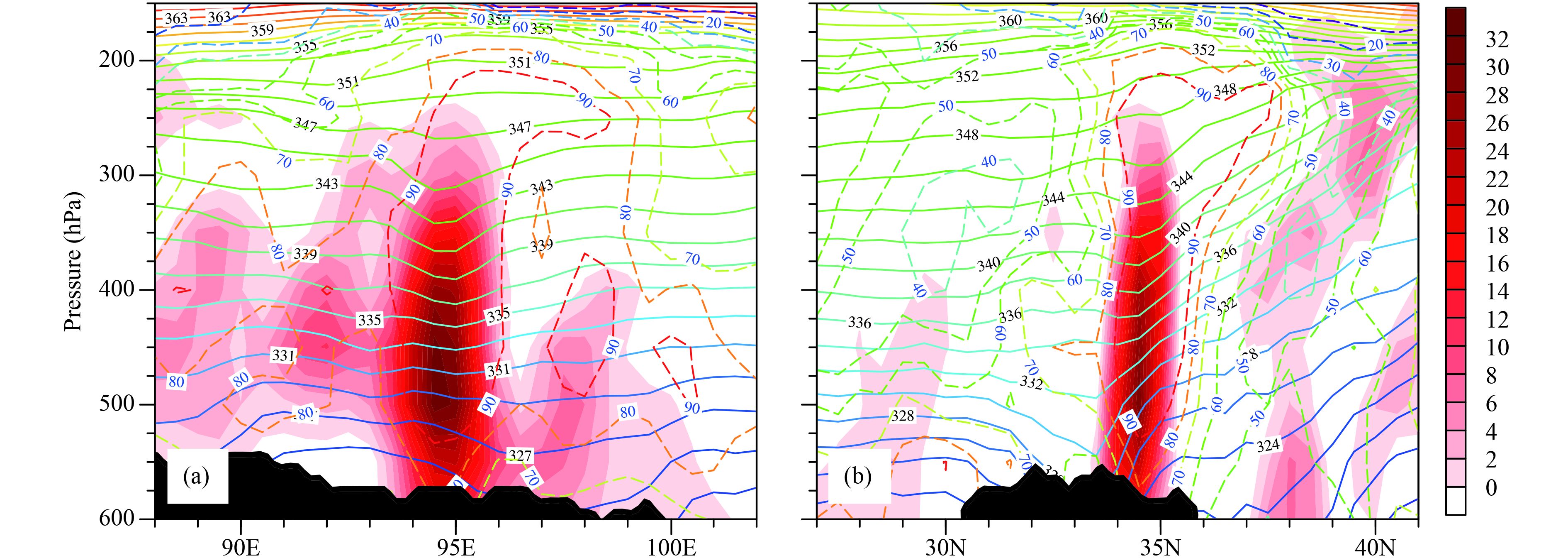
|
| Figure 4 The composite relative vorticity (shading; 10–5 s–1), potential temperature (solid line; K), and relative humidity (dashed line; %) along the (a) west–east and (b) south–north cross-sections for the type-I TPV through the center (34.5°N, 95°E). The dark shading represents orography. |
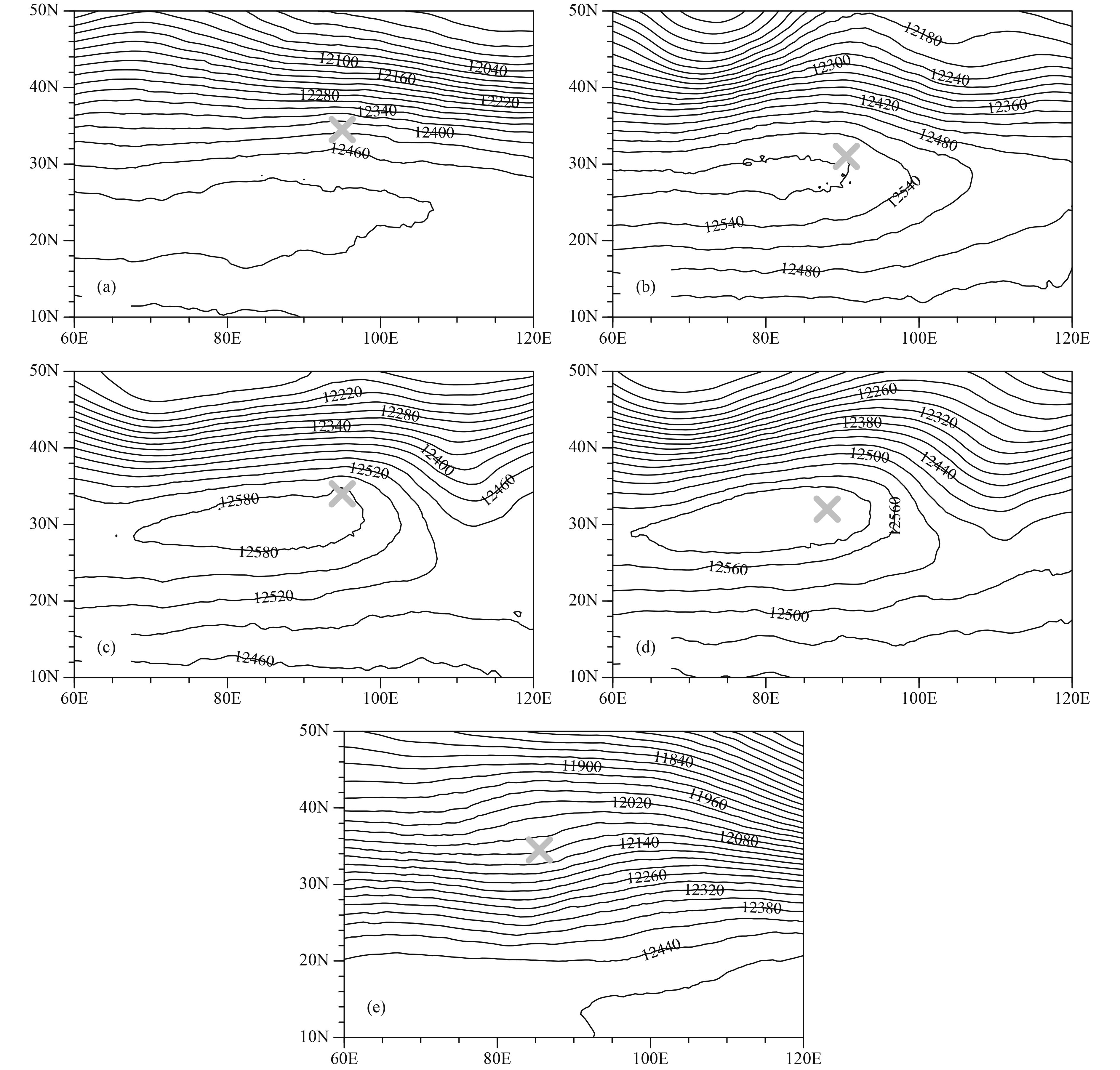
|
| Figure 5 Composite 200-hPa geopotential height (gpm) fields for TPVs of (a) type I, (b) type IV, (c) type IIa, (d) type IIb, and (e) type III. The composite vortex center at 500 hPa is marked by a gray cross. |
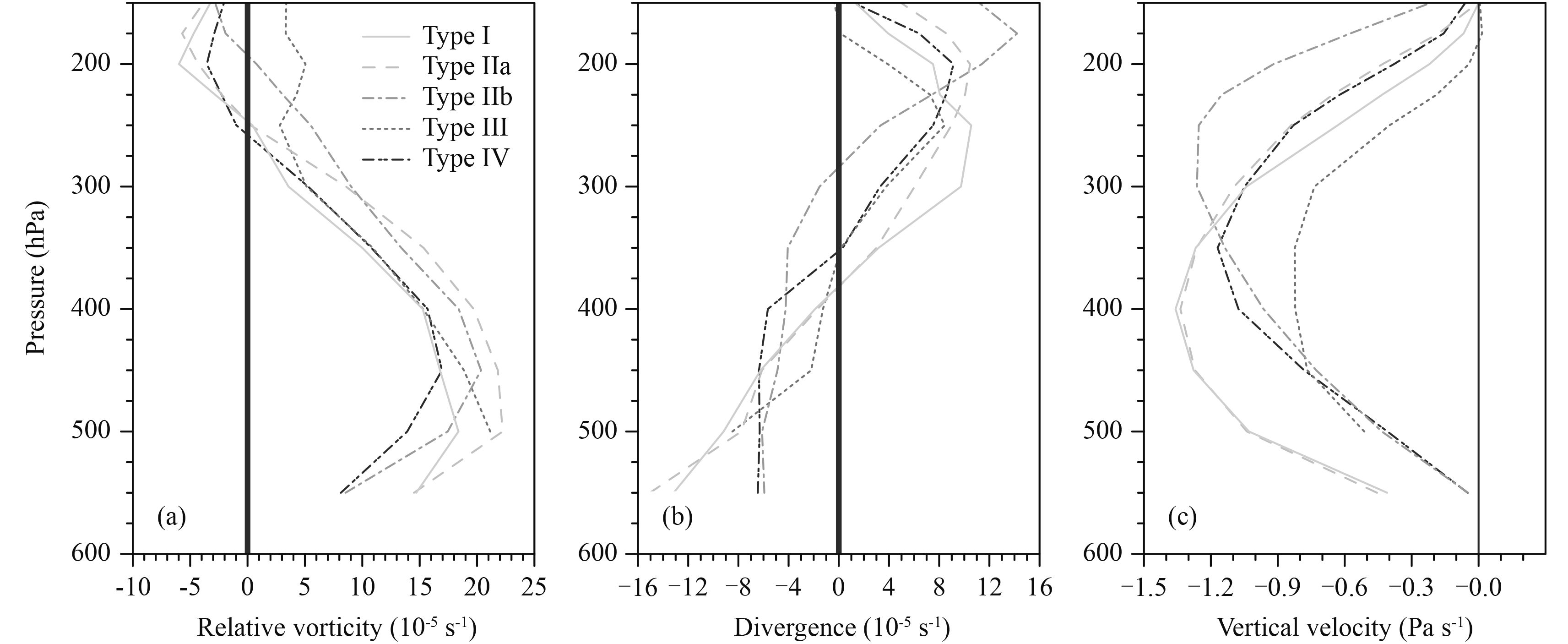
|
| Figure 6 The composite (a) relative vorticity (10–5 s–1), (b) divergence (10–5 s–1), and (c) vertical velocity (Pa s–1) profiles through the center of each TPV type. The vertical profile for each composite vortex is represented by the mean values of the nine grid points, combining the vortex center point plus the eight surrounding grid points. |
The cyclonic circulation extends from the ground to 250 hPa in the vertical direction, which peaks at 500 hPa, as shown by the vertical slices and profiles along the vortex center in Figs. 4, 6. Strong convergence controls below 400 hPa, while divergence dominates above this level. The upward motion is strong and extends to above 200 hPa. The low-level convergence, upper-level divergence, and vertical motion attain their maximum inten-sity at 550, 250, and 400 hPa, respectively.
Additionally, a detailed examination illustrates that the structure of the type-I TPV is further complicated by the geographical position of the vortex. When the vortex lies to the west, the dense isotropic area at low levels sometimes exhibits a northeast–southwest-oriented pattern, with a southeastward gradient of potential temperature (figure omitted). Accordingly, the vortex system takes on a northeast–southwest elongated morphology in the geopotential height and relative vorticity fields, and the centers of cyclonic circulation, convergence, and upward vertical velocity tilt toward the northwest with height. In contrast, when the vortex lies to the east (near 100°E) and is affected by a cold-air intrusion from the northeast, it is observed in the confluent region of the northeasterly and southeasterly flows, with a southwestward gradient of potential temperature and a northeastward tilting with height (figure omitted). Morever, an anticyclonic circulation exists over the northeastern flank of the plateau at 550 hPa.
As described above, type-I TPVs are frequently observed in a west–east-oriented zone between 33° and 36°N, and form predominately within a large-scale confluence zone of the northwesterly/northerly and southwesterly flows. Qian et al. (1984) calculated barotropic instability at 500 and 400 hPa as a function of latitude in the range of the main body of the plateau and indicated that a barotropic instability zonal region exists along approximately 34°N at low levels in the presence of TPVs; meanwhile, the instability zone disappears in the abse-nce of vortices. The barotropic instability, closely associated with the horizontal shear of air flows, could be essen-tial for the formation and development of this type of TPV.
3.2 Heavy precipitating TPVs (type II)3.2.1 Baroclinicity at low levels (type IIa)Type-IIa TPVs usually occur during July–August and are associated with heavy precipitation. This type of vortex is preferentially generated in the area (32°–35°N, 86°–94°E), and an overwhelming majority (79%) is moving systems. They tend to travel eastward to east of 90°E, potentially moving out of the plateau, as shown in Fig. 2b.
The composite system of this sub-category centers at 34°N, 95°E and has a deep structure, with the vertical extension of the low-pressure system from approximately 550 to 350 hPa. As shown in the potential temperature field (Fig. 7), the low-level vortex features baroclinicity, while the mid–upper levels have a warm center, almost overlapping with the vortex center. A low-level jet (LLJ) is seen in the south of the vortex within 500–400 hPa, conducive to northward transport of water vapor favorable for the development of heavy precipitation, and its composite wind speed exceeds 12 m s–1. The vortex system displays a meso low trough at 350 hPa, and then becomes a meso high ridge above 250 hPa. The upper troposphere is controlled by the SAH, which is centered at about 30°N, 83°E (Fig. 5c). Furthermore, the vortex system is collocated with northeastern SAH.
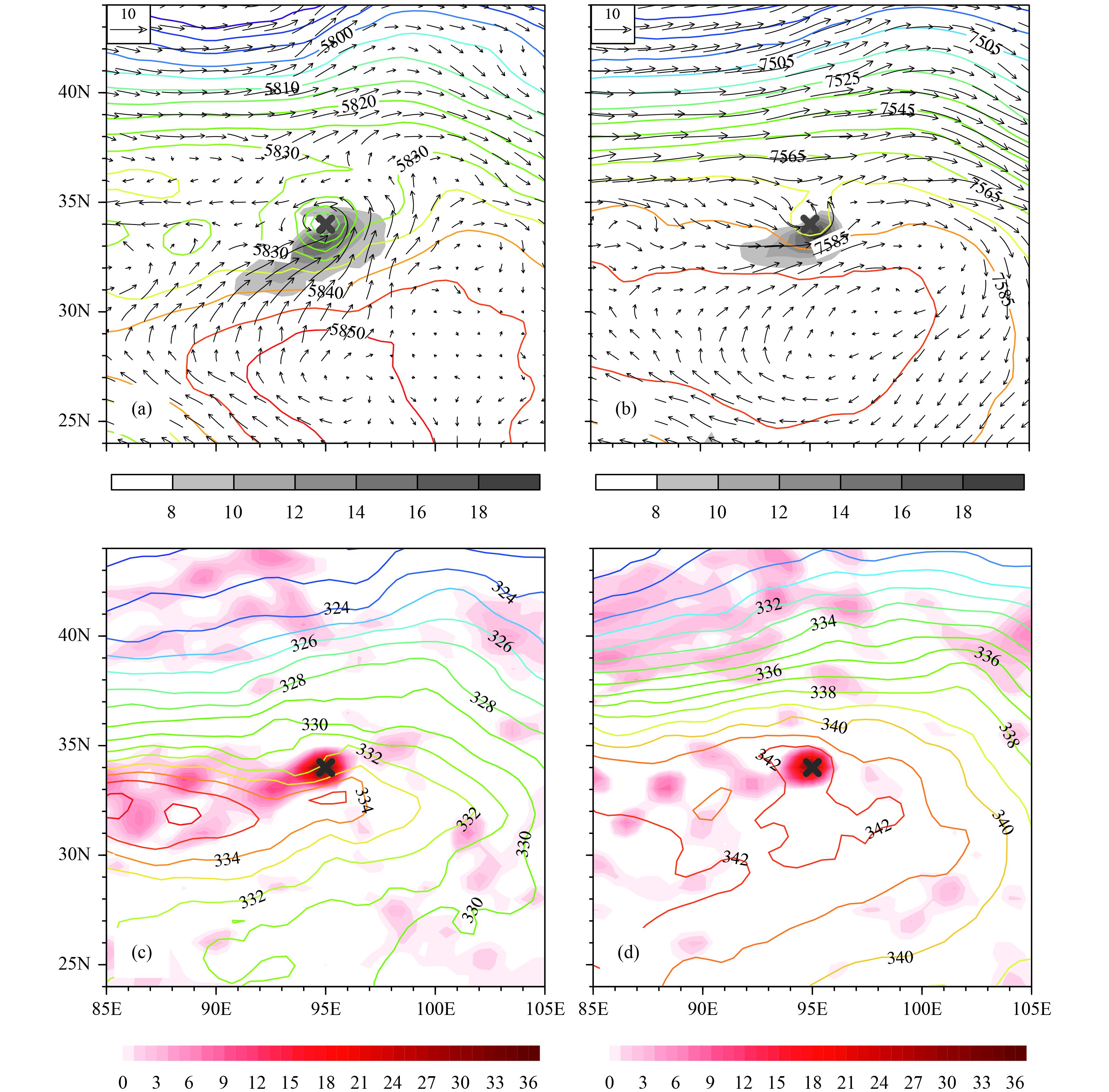
|
| Figure 7 The composite (a, b) geopotential height (contours; gpm), wind vectors, and isotach (shading; m s–1) fields, and (c, d) relative vorticity (shading; 10–5 s–1) and potential temperature (contours; K) fields of the type-IIa TPV. Panels (a) and (c) represent the physical fields at 500 hPa, and panels (b, d) at 400 hPa. The composite vortex center at 500 hPa is marked by a black gray cross. |
Vertical slices and profiles of the composite vortex are shown in Figs. 8 and 6. The deep cyclonic vorticity extends up to 250 hPa in the vertical direction and peaks at 500 hPa. The convergence–divergence distribution is demarcated near 400 hPa, attaining a maximum at 550 and 200 hPa, respectively. The ascending motion extends beyond 150 hPa and peaks at 400 hPa.
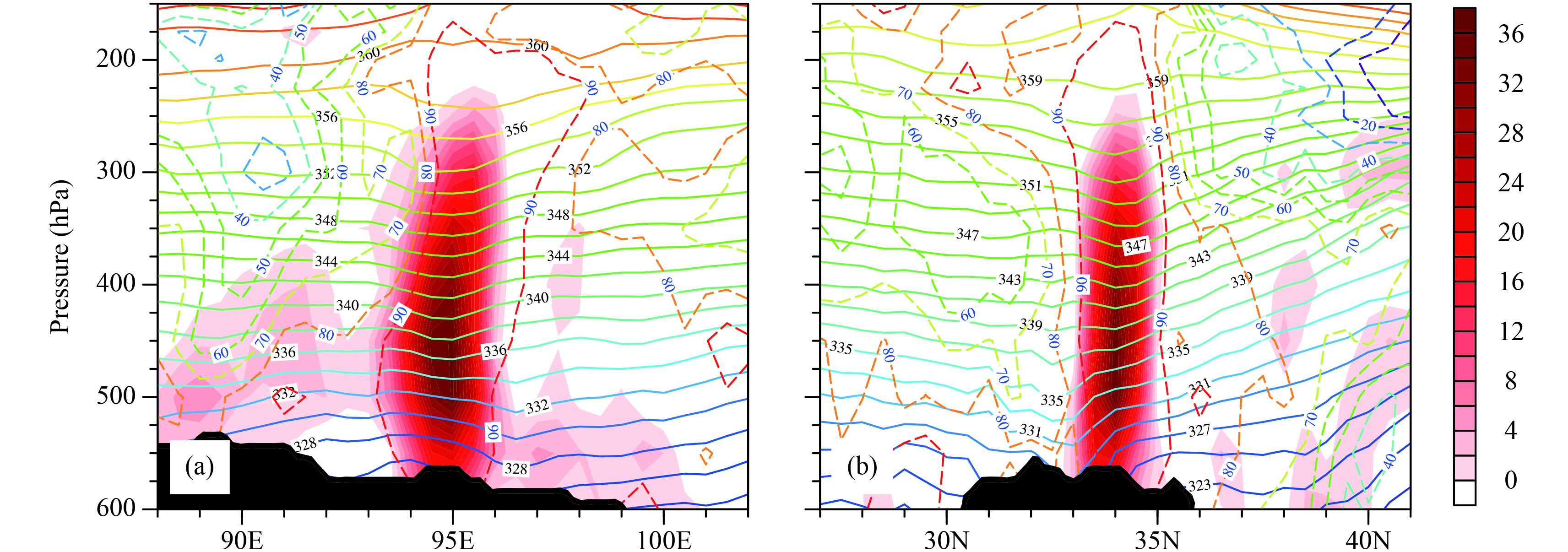
|
| Figure 8 As in Fig. 4, but for the composite type-IIa TPV along the vortex center (34°N, 95°E). |
Both the type-I and type-IIa vortices show the presence of low-level baroclinicity. They predominantly travel eastward, sometimes move out of the plateau, and tend to produce precipitation. However, some evident differences exist between the two categories. The type-IIa TPV occurs during July–August and corresponds to a stronger and deeper vortex circulation, which is associated with heavy rainfall and an LLJ, whereas the type-I TPV is observed throughout the entire warm season and presents stronger baroclinicity at low levels. In addition, the type-I vortex takes on a visible westward elongated morphology in the physical fields and resides within the large-scale confluent zone of the northwesterly/northerly and southwesterly flows at 500 hPa. However, for the type-IIa vortex are absent, except for the elongated morphology in the convergence field only during vortex genesis. Therefore, it is speculated that the large-scale confluence is essential to the formation and development of type-I TPVs, while other development mechanisms (such as latent heating associated with heavy rainfall) are dominant during type-IIa development. Another notable disparity resides in the SAH, insofar as—when a type-IIa TPV occurs—it controls the upper troposphere over the entire plateau and the ridge line is situated at 30°N; whereas, during type-I TPV activity, the SAH displays a weaker intensity and a southward shift of the ridge line, and dominates over the southern plateau. Accordingly, for the type-I vortex, westerly flow dominates the area south of 30°N in the middle and upper troposphere; whereas, for the type-IIa vortex, easterly flow prevails due to the influence of the SAH.
3.2.2 Low-level cold core and mid–upper-level warm core (type IIb)Type IIb is the other sub-category of deep vortices, occurring during July–August and producing heavy precipitation. However, most (90%) of these vortices are quasi-stationary and dissipate in the neighborhood of their origin. The vortex frequently occurs west of 92°E over the plateau, and is barely observed in the eastern plateau, as shown in Fig. 2c.
The composite vortex centers at 32°N, 88°E, 2° due south of the composite type-IIa vortex, and is vertically confined to a deep layer between 550 and 300 hPa, displaying a quasi-circular low and vortex circulation (Fig. 9). It possesses a near upright structure. As shown in Fig. 10, a cold center presents below approximately 450 hPa, while there is warm center aloft. The cold/warm core overlaps with the vortex center. At 200 hPa (Fig. 5d), the system becomes a meso high in the interior of the SAH. The ridge line of the SAH lies near 30°N.

|
| Figure 9 As in Fig. 3, but for the physical fields of the composite type-IIb TPV, whose center is located at 32°N, 88°E. |
As shown in the vertical cross sections and profiles (Figs. 10, 6), as compared with the type-IIa vortex, the vortex system attains maxima of positive vorticity, low-level convergence, upper-level divergence, and upward motion at higher altitudes, peaking at 450, 550–500, 175, and 300–250 hPa, respectively. It should be pointed out that the upper-level divergence is remarkably stronger than the low-level convergence in intensity (as shown in Fig. 6). This unique feature is very likely attributable to the coupling of upper-level divergence between the vortex and the SAH, leading to the deepest vorticity circulation among all the different types of TPV.
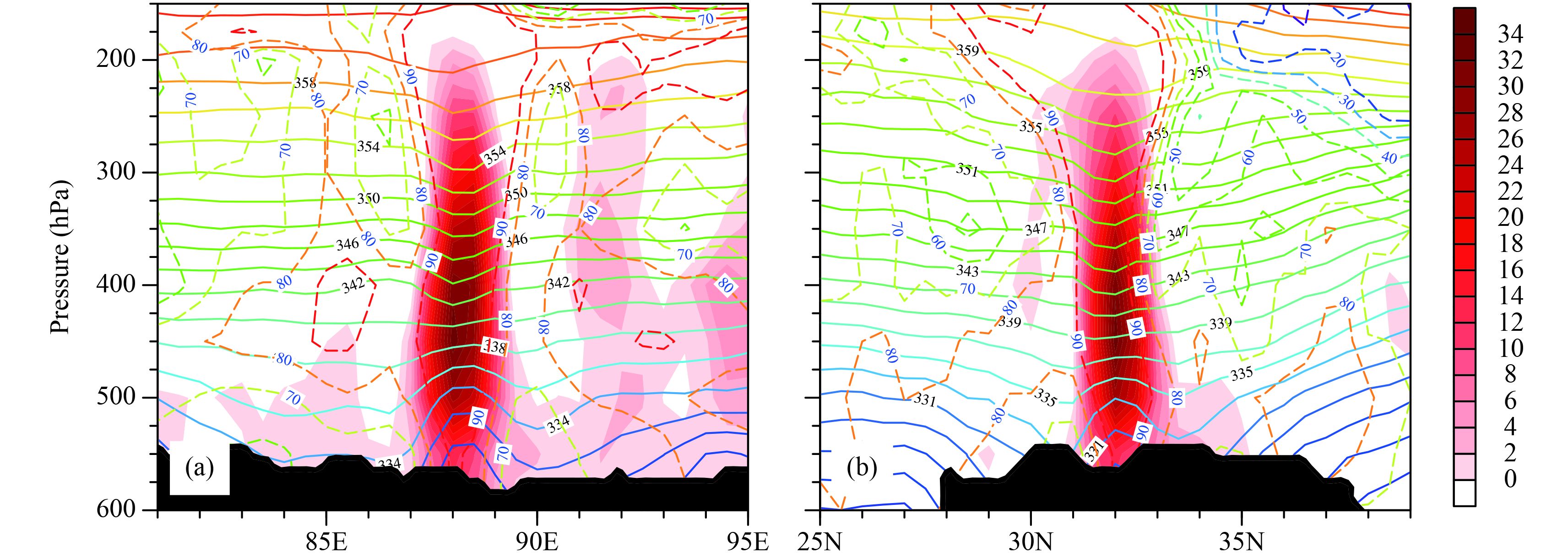
|
| Figure 10 As in Fig. 4, but for the composite type-IIb TPV along the vortex center (32°N, 88°E). |
Evident disparities exist between the two sub-categories of heavy precipitating TPVs. Type IIb is a quasi-stationary system generated in the western plateau. Its structure shows cold anomalies at low levels and the cold core overlaps the vortex center. However, type IIa preferentially travels to the eastern plateau, potentially moves out of the plateau, and displays the presence of low-level baroclinicity in thermal structure. Moreover, in the upper troposphere, the type-IIb vortex lies in the interior of the SAH and the center of the SAH presents a somewhat westward shift; meanwhile, the type-IIa vortex is situated in the northeastern part of the SAH. Besides, an LLJ exists in the south of the vortex for type IIa. These structural differences may be responsible for the significant disparity in the translation behavior between these two sub-categories.
3.3 Dry TPVs in the western plateau (type III)The type-III category of TPVs refers to a shallow and dry (i.e., non- or very weakly precipitating) vortex system observed over the high-elevated western plateau (west of 90°E), as shown in Fig. 2d. It occurs frequently during April–May and rarely during July–August. The vortex often travels a rather limited distance, partly due to its short lifetime, and dissipates in the neighborhood of its origin in the western and central plateau.
The composite vortex is centered at 34.5°N, 85.5°E. Owing to the 500-hPa isobaric surface being close to the ground of the highly elevated western plateau, the vertical development of the vortex is restricted such that the low system is confined to a layer approximately 100 hPa deep (extending from approximately 500 to 400 hPa) in the geopotential height fields, leading to the shallowest vortex among all the categories. The entire column of the vortex system is anomalously warm. As shown in Fig. 11, the vortex lies in the warm area and displays very weak baroclinicity at 500 hPa. Between 450 and 300 hPa, the warm center overlaps the vortex center and the warm core strengthens with height. The zonal circulation dominates the large-scale environmental flows. Above 350 hPa, the vortex couples to a low trough and is located in its front. The ridge line of the SAH occurs south of 15°N at 200 hPa and then the straight westerly flow prevails in the main body of the plateau (Fig. 5e). A large area of positive vorticity exists near the vortex system in the upper troposphere. In addition, when the vortex presents somewhat greater baroclinicity at low levels (500–400 hPa), it is capable of moving to the eastern plateau, but incapable of moving out of the plateau.
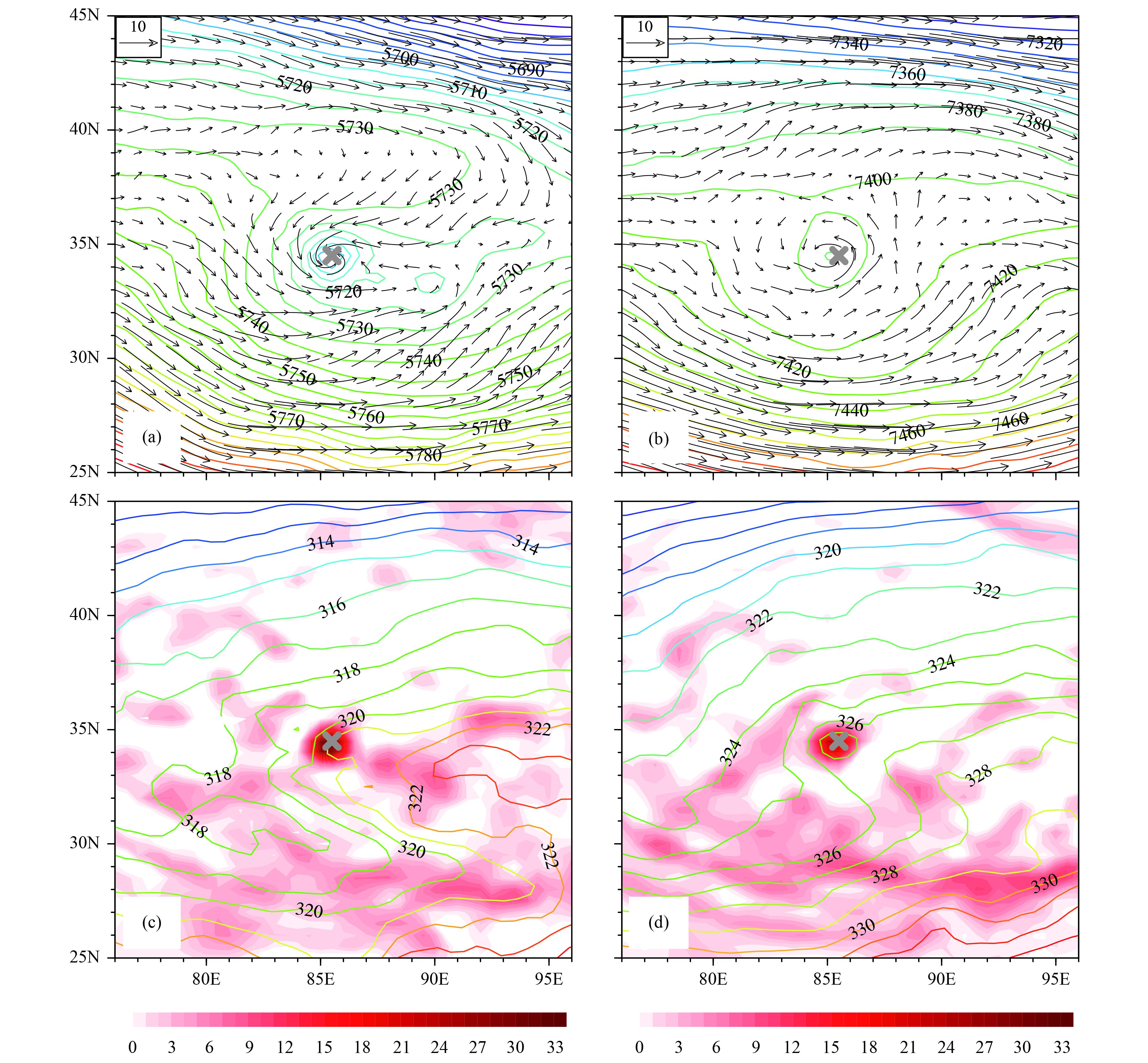
|
| Figure 11 As in Fig. 3, but for the physical fields of the composite type-III TPV, whose center is located at 34.5°N, 85.5°E. |
Because of the high elevation of the underlying surface, the maximum values of relative vorticity and convergence in the vertical direction occur near the ground, and their centers overlap with the warm and high humidity core, which suggests that elevated surface sensible heating could be essential for the genesis and development of this category. The vertical cross-sections (Fig. 12) and profiles (Fig. 6) show that the cyclonic vorticity extends beyond 250 hPa and peaks at 500 hPa. The convergence, divergence and upward motion attain their maxima at 500, 250, and 400–350 hPa, respectively. The convergence–divergence pattern is demarcated at approximately 350 hPa.
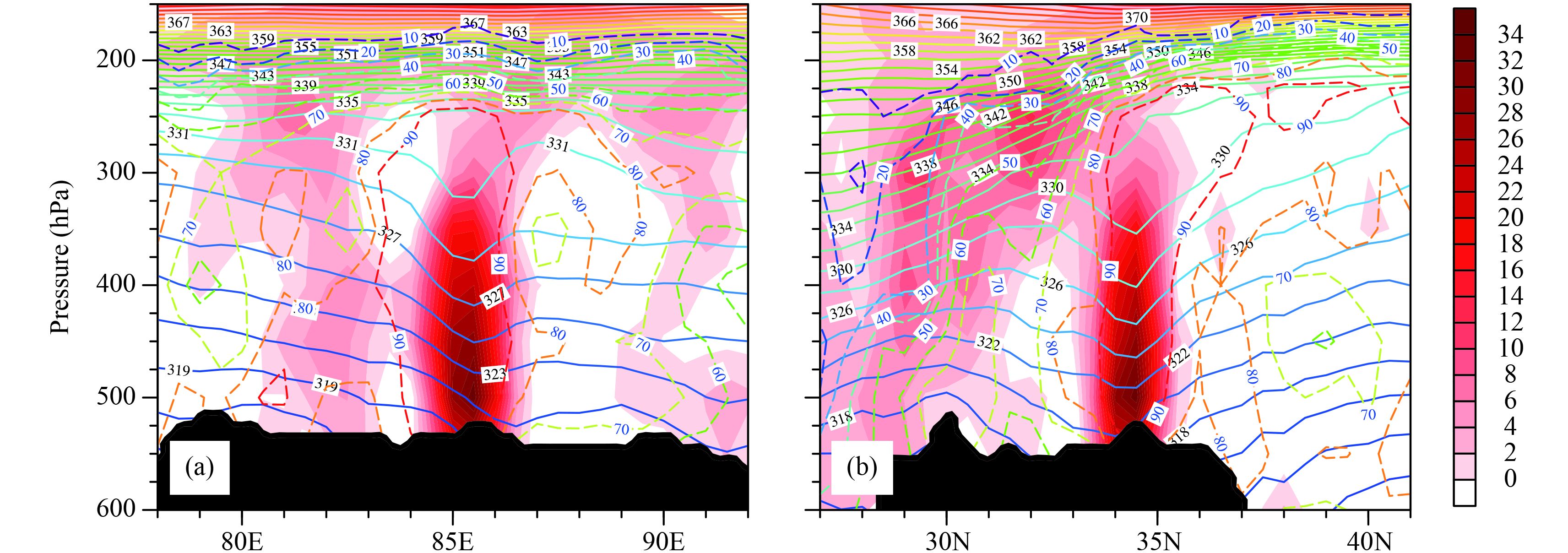
|
| Figure 12 As in Fig. 4, but for the composite type-III TPV along the vortex center (34.5°N, 85.5°E). |
This type of TPV occurs during July–August over the southern plateau (south of 32°N and west of 92°E), as shown in Fig. 2e, and is often associated with rainfall. It tends to dissipate near the place where it originates.
The composite vortex is a quasi-symmetrical system, which is centered at 31°N, 90.5°E and is confined to 550–350 hPa in the geopotential height field. The vortex center is collocated with the cold center at 550 hPa and the warm centers at and above 400 hPa, as shown in Fig. 13. The environmental relative vorticity surrounding the vortex system is mainly anticyclonic. Of note is that the low-level vortex is barely impacted by the northerly flow, due to its geographical position far away from the northern flank of the plateau. At 500 hPa, southerly and southwesterly flows dominate south of the vortex, while easterly and southeasterly flows prevail to the north. Referring to the plateau terrain (Fig. 1), the vortex is located between two west–east-oriented mountains in the central and southern plateau: the Tanggula and Nianqingtanggula mountains. The mid-tropospheric disturbances north of the plateau are mostly blocked by Tanggula Mountain (extending along 33°N, approximately) and barely influence the low levels of the vortex. It is speculated that the genesis and development of this type of TPV is closely related to the thermodynamic factors and mechanical forcing of topography in the interior area of the plateau. Above 450 hPa, however, the orographic obstruction disappears, allowing the northwesterly and northerly flows to exert an influence on the northern and western part of the vortex. A banded SAH controls the middle and upper levels and its ridge line lies at 29°N (Fig. 5b). A meso high ridge is coupled to the vortex system above 250 hPa. As evinced in the vertical cross-sections (Fig. 14) and profiles (Fig. 6), the relative vorticity, low-level convergence, upper-level divergence, and upward motion of the vortex system peak at 450, 450, 200, and 350 hPa, respectively.

|
| Figure 13 As in Fig. 3, but for the physical fields of the composite type-IV TPV, whose center is located at 31°N, 90.5°E. |
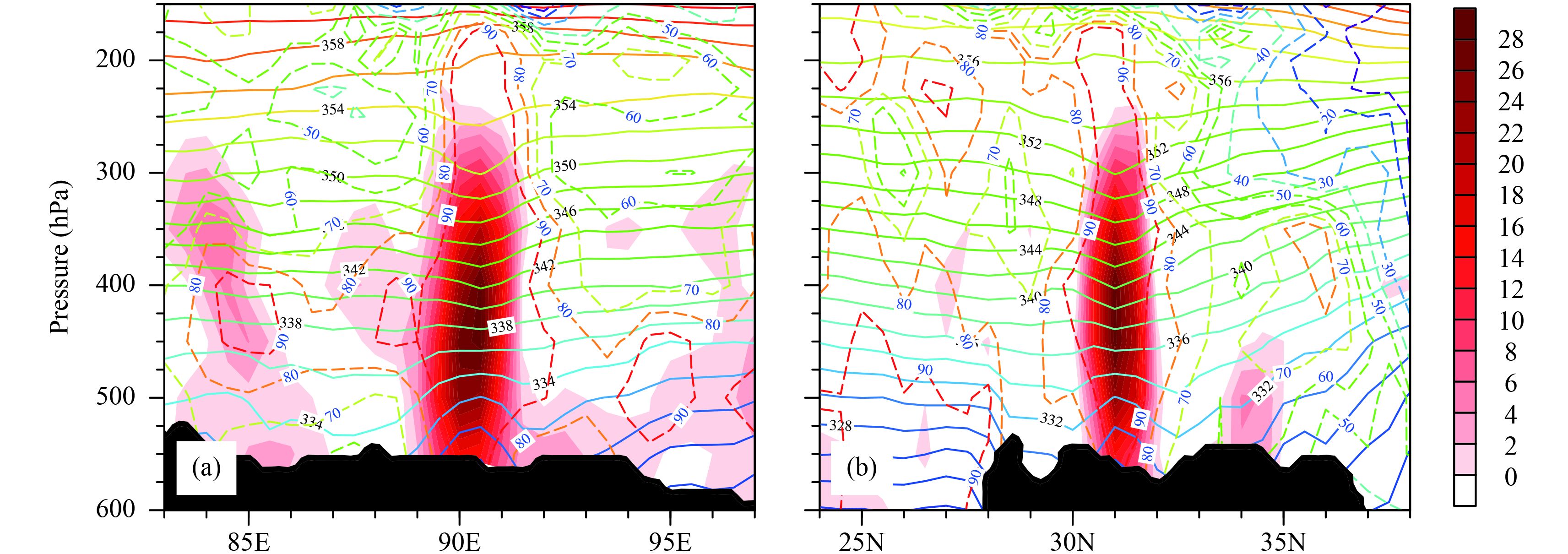
|
| Figure 14 As in Fig. 4, but for the composite type-IV TPV along the vortex center (31°N, 90.5°E). |
The main features of the four types of TPV discussed in this study are summarized in Table 1. As demonstrated in the above analysis of the structures of the different TPV types, heavy-rain vortices are typically deep and intense, while dry vortices are generally shallow and weak. In the middle and upper levels of the vortex (at and above 400 hPa), the warm center strengthens with height, meaning a concave isotropic pattern becomes increasingly visible in the vertical cross-sections. This feature indicates that diabatic heating created by water vapor phase changes could have an important impact on vortex development.
| Structure | SAH | Precipitation | Primary area of TPV activity | Preferential season | Translation attribute | |
| Type I | Asymmetric system; residing within a large-scale confluent zone of northwesterly/northerly and southwesterly flows; low-level baroclinicity | Banded or western pattern; ridge line at 23°N at 200 hPa | Existence | West–east-oriented zonal region between 33° and 36°N | No preference | Preferentially traveling eastward, potentially moving out of the plateau |
| Type IIa | Deep geopotential height fields (vertical extension from 550 to 350 hPa, approximately); low-level baroclinicity; an LLJ in the south of the TPV | Western pattern; ridge line at 30°N; TPV in northeastern SAH | Heavy | Generated in the area (32°–35°N, 86°–94°E), then moving east of 90°E | Midsummer | Traveling eastward, potentially moving out of the plateau |
| Type IIb | Deep geopotential height fields; almost upright and quasi-symmetrical system; low-level cold core; notably stronger upper-level divergence than low-level convergence | Western pattern; ridge line at 30°N; TPV in the interior SAH | Heavy | Entire life cycle spent west of 92°E | Midsummer | Quasi-stationary |
| Type III | Shallow (confined to 500–400 hPa, approximately); anomalously warm; positive vorticity and convergence centers near the ground with overlapping warm core | Not over the TP; ridge line at 15°N | Non-existence (or very weak precipitation) | Western plateau (west of 90°E) | Spring | Dissipating in the neighborhood of its origin |
| Type IV | Vertically aligned system with cold center at low levels; low levels of the TPV unaffected by northerly flow due to topographic blocking | Banded SAH; ridge line at 29°N | Existence | Southern plateau (south of 32°N and west of 92°E) | July–August | Dissipating in the neighborhood of its origin |
In view of the relationship between the thermal structure and attributes of translation, a TPV possessing low-level baroclinicity preferentially travels eastward, as shown in Table 1. Some of the type-I and type-IIa vortices even move out of the plateau and exert an impact on downstream weather and precipitation. However, other vortices, displaying a center overlapping with the low-level cold core and upper-level warm core, tend to dissipate in the neighborhood of their origin. Even if traveling eastward, such a vortex will dissipate in the eastern plateau and is unable to move out of the plateau without variability in structure. Although some differences exist in the low-level thermal structure among all categories, it is shown that they share a fundamental commonality, that is, the presence of a low-level large-scale warm region. The vortex occurs either inside the large-scale warm region or on its periphery (accordingly presenting a baroclinic nature). The existence of a heat source indicates that sensitive heating could play an important role in vortex formation.
The SAH is suggested as another important factor influencing TPV structure. It is the strongest and steadiest circulation system (most notably at 100 hPa) over the Northern Hemisphere, typical of the warm season. The formation of the SAH is related to the unique topography and geographic position of the plateau. The relationship between the TPV and SAH is highlighted in two respects: the influence of the SAH on those vortices that move out of the plateau, and the clustering of vortex genesis modulated by the east–west oscillation of the SAH (Lhasa Research Group on Qinghai–Xizang Plateau Meteorology, 1981; Sun et al., 1987; Li et al., 2012). Besides these two aspects, the present paper reveals the influence of the SAH on the structure of vortices observed over the main body of the plateau. As shown in Fig. 4 and Table 1, salient disparities exist in the SAH circulation situation among the activities of various TPVs. A precipitating vortex (i.e., types I, II, and IV) usually occurs in northern and eastern SAH, and sometimes in its interior (i.e., type IIb). Among them, the heavy precipitating case (i.e., type II) corresponds to the strongest SAH that expands farther north. However, as a dry vortex (i.e., type III) occurs, the SAH is weak and does not lie over the plateau, due to southeastern retreat. This might contribute to the fact that this category of vortex is shallow and non-precipitating or very weakly precipitating. Additionally, the SAH features east–west oscillation, with which some structural characteristics of precipitating vortices are associated. According to their center position and intensity, the SAH systems are divided into three groups: western, eastern, and banded patterns. A heavy precipitating vortex (i.e., type II) occurs under the circulation situation of a western-pattern SAH, while type-I and type-IV vortices correspond to the banded or western pattern. Certainly, much additional work is required in order to understand the mechanism by which the SAH influences TPV structure.
The dynamic and thermodynamic structures of TPVs are deeply affected by their geographical location, the season, their translation properties, and the existence or non-existence of associated precipitation. This implies that some disparities may exist in the formation and development mechanisms of TPVs among different categories. At the very least, factors such as sensitive and latent heating and orographic forcing may contribute to the formation and development of different TPVs to different degrees. The contributions of factors for different TPV types will be assessed through future modeling research, in order to detect their genesis and development mechanisms. Additionally, the present work focuses on the vortex structure at maturity. The structure might vary as the vortex develops. Hence, the structural features at different stages of development warrant further investigation. Besides the mature stage of vortices, the dynamic and thermal structures during other stages (i.e., initiation, development, and dissipation) and their evolution will be further examined in future work.
5 ConclusionsThe NCEP-CFSR dataset is used in the present work to systematically investigate the general structural characteristics of various types of TPV at maturity, through inspection and physical classification of a large number of vortices followed by composite analysis. The vortices exhibit unique complexity and variety in structure, with more categories than previously known; earlier work focused almost exclusively on thermal structure, especially on the zonal anomaly of temperature, when classifying TPVs. The dynamic and thermodynamic structures of TPVs are deeply affected by their geographical location, the season, their translation properties, the existence or non-existence of associated precipitation, and the SAH. Our major findings can be summarized as follows.
(1) Type-I TPVs, which are asymmetric systems with associated precipitation, are quite common. They occur dominantly in a west–east-oriented zonal region between 33° and 36°N, and preferentially travel eastward, even moving out of the plateau. This type of vortex system resides within a large-scale confluent zone of northwesterly/northerly and southwesterly flows. It features apparent baroclinicity in the low levels, and has a warm center in the mid–upper levels. The SAH retreats southward, and then its ridge line approximately locates along 23°N at 200 hPa.
(2) Heavy precipitating TPVs (type II) occur during midsummer and possess a deep structure. Low-level baroclinic vortices (type IIa) often generate in the area (32°–35°N, 86°–94°E) and then move east of 90°E, potentially moving out of the plateau. Meanwhile, the nearly upright system (type IIb), which has a cold center in the low levels and warm center in the mid and upper levels, tends to be a quasi-stationary and quasi-symmetrical system and stays west of 92°E in the plateau during its entire life cycle. Additionally, type-IIa TPVs are associated with an LLJ in the south of the vortex. As compared to its type-IIa counterpart, a type-IIb TPV attains its maxima of positive vorticity, low-level convergence, upper-level divergence and upward motion at higher altitudes, and the upper-level divergence is notably stronger than the low-level convergence in intensity. For both sub-categories, the upper troposphere over the plateau is controlled by the SAH, with its ridge line lying near 30°N. Somewhat differently, type IIa is located in northeastern SAH, while type IIb lies in the interior and is associated with an upper-tropospheric meso high.
(3) The dry vortex in the western plateau, preferentially occurring in the spring (type III), is anomalously warm and shallow (mostly confined to 500–400 hPa, approximately), and often dissipates in the neighborhood of its origin. It displays positive vorticity and convergence centers near the ground, overlapping a warm core, presumably due to the high altitude of the ground in the western plateau. The zonal circulation controls the large-scale environmental flows in the middle troposphere. In the upper troposphere, straight westerly flows prevail and a large area of positive vorticity exists near the vortex system. The SAH retreats farther southward, with its ridge line lying south of 15°N.
(4) The precipitating vortex in the southern plateau during July–August (type IV) is a vertically aligned system (approximately 200 hPa deep) collocated with cold temperatures at low levels and warm temperatures aloft. It tends to dissipate near the place where it originates. Because of the specific geographical position, the mid-tropospheric northerly flow is blocked by mountains north of the vortex location, and is then unable to exert any influence at low levels of the vortex. The mid–upper levels are dominated by a banded SAH, presenting its ridge line at 29°N.
(5) The generation and development for all categories of TPV is associated with a low-level and large-scale warm region. However, low-level baroclinic vortices preferentially travel eastward, potentially moving out of the plateau, whereas the nearly upright systems with a cold center at low levels and warm center at upper levels tend to dissipate in the neighborhood of their origin. The TPV is also closely associated with the SAH. The latter modulates the vortex structures through its relative position, circulation situation, and east–west oscillation.
| Alexer M. A., Seo H., Xie S. P., et al.,2012: ENSO’s impact on the gap wind regions of the eastern tropical Pacific Ocean. J. Climate, 25, 3549–3565. DOI:10.1175/JCLI-D-11-00320.1 |
| Bao X. H., Zhang F. Q., 2013: Evaluation of NCEP-CFSR, NCEP–NCAR, ERA-Interim, and ERA-40 reanalysis datasets against independent sounding observations over the Tibetan Plateau. J. Climate, 26, 206–214. DOI:10.1175/JCLI-D-12-00056.1 |
| Dieng A. L., Eymard L., Sall S. M., et al.,2014: Analysis of strengthening and dissipating mesoscale convective systems propagating off the West African coast. Mon. Wea. Rev., 142, 4600–4623. DOI:10.1175/MWR-D-13-00388.1 |
| Feng X. Y., Liu C. H., Rasmussen R., et al.,2014: A 10-yr climatology of Tibetan Plateau vortices with NCEP Climate Forecast System Reanalysis. J. Appl. Meteor. Climatol., 53, 34–46. DOI:10.1175/JAMC-D-13-014.1 |
| Feng X. Y., Liu C. H., Fan G. Z., et al.,2016: Climatology and structures of southwest vortices in the NCEP Climate Forecast System Reanalysis. J. Climate, 29, 7675–7701. DOI:10.1175/JCLI-D-15-0813.1 |
| Gao W. L., Yu S. H., 2007: Analyses on mean circulation field of the plateau low vortex moving out of Tibetan Plateau. Plateau Meteor., 26, 206–212. |
| Lhasa Research Group on Qinghai–Xizang Plateau Meteorology, 1981: A Study of 500-mb Vortexes and Shearlines over the Qinghai–Xizang Plateau in the Warm Season. Science Press, Beijing, 122 pp. (in Chinese) |
| Li G. P., Jiang J., 2000: A type of singular solitary wave and its application of structure analysis of the Tibetan Plateau vortex. Acta Meteor. Sinica, 58, 447–456. |
| Li G. P., Zhao F. H., Huang C. H., et al.,2014: Analysis of 30-year climatology of the Tibetan Plateau vortex in summer with NCEP reanalysis data. Chinese J. Atmos. Sci., 38, 756–769. |
| Li H., Colle B. A., 2014: Multidecadal changes in the frequency and ambient conditions of warm season convective storms over the northeastern United States. J. Climate, 27, 7285–7300. DOI:10.1175/JCLI-D-13-00785.1 |
| Li J. P., Wang S. G., Sun G. W., 2012: Review and prospects of research on low vortex on the Qinghai–Tibetan Plateau. Journal of Lanzhou University (Natural Sciences), 48, 53–60, 71. |
| Lin Z. Q., 2015: Analysis of Tibetan Plateau vortex activities using ERA-Interim data for the period 1979–2013. J. Meteor. Res., 29, 720–734. DOI:10.1007/s13351-015-4273-x |
| Liu C., Li Y. Q., Li D. J., 2009: Analysis on the dynamic structure of vortex moving out of the Tibetan Plateau. Plateau and Mountain Meteorology Research, 29, 8–11. |
| Luo, S. W., 1992: A Study on Some Kinds of Weather Systems over and Around the Qinghai–Xizang Plateau. China Meteorological Press, Beijing, 205 pp. (in Chinese) |
| Luo S. W., He M. L., Liu X. D., 1993: A study on the Tibetan Plateau vortex in summer. Science in China (Series B), 23, 778–784. |
| Lyu, J. N., and C. S. Zheng, 1984: Study on the Tibetan Plateau vortices before the rainy season. Collected Works of QXPMEX (I). Science Press, Beijing, 218-228. (in Chinese) |
| Lyu, J. N., Z. A. Qian, F. M. Shan, et al., 1984: Comprehensive structure of the summertime Tibetan Plateau vortex. Collected Works of QXPMEX (II). Science Press, Beijing, 195–205. (in Chinese) |
| Qiao, Q. M., and Y. G. Zhang, 1994: Synoptic Meteorology of the Qinghai–Xizang Plateau. China Meteorological Press, Beijing, 250 pp. (in Chinese) |
| Qian, Z. A., F. M. Shan, J. N. Lv, et al., 1984: Statistics of Qinghai–Xizang Plateau vortices for the summer of 1979 and discussions of the climatological factors for the vortex genesis. Collected Works of QXPMEX (II). Science Press, Beijing, 182–194. (in Chinese) |
| Saha S., Moorthi S., Pan H. L., et al.,2010: The NCEP climate forecast system reanalysis. Bull. Amer. Meteor. Soc., 91, 1015–1057. DOI:10.1175/2010BAMS3001.1 |
| Sun G. W., Chen B. D., Wu J. C., et al.,1987: Dynamic effects of large scale environment field on eastward moving and development of lows over the Qinghai–Xizang Plateau. Plateau Meteor., 6, 225–233. |
| Wang A. H., Zeng X. B., 2012: Evaluation of multi-reanalysis products with in situ observations over the Tibetan Plateau. J. Geophys. Res., 117(D5). DOI:10.1029/2011JD016553 |
| Wang X., Li Y. Q., Yu S. H., et al.,2009: Statistical study on the plateau low vortex activities. Plateau Meteor., 28, 64–71. |
| Weaver S. J., Wang W. Q., Chen M. Y., et al.,2011: Representation of MJO variability in the NCEP climate forecast system. J. Climate, 24, 4676–4694. DOI:10.1175/2011JCLI4188.1 |
| Wen C. H., Xue Y., Kumar A., 2012: Ocean–atmosphere characteristics of tropical instability waves simulated in the NCEP Climate Forecast System Reanalysis. J. Climate, 25, 6409–6425. DOI:10.1175/JCLI-D-11-00477.1 |
| Yu S. H., Gao W. L., Gu Q. Y., 2007: The middle–upper circulation analyses of the plateau vortex moving out of plateau and influencing flood in East China in recent years. Plateau Meteor., 26, 466–475. |
 2017, Vol. 31
2017, Vol. 31


